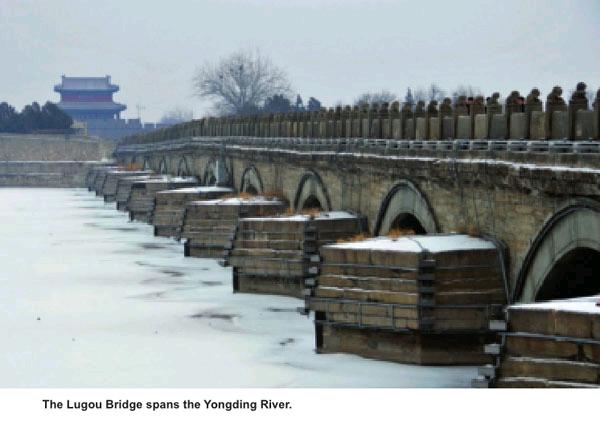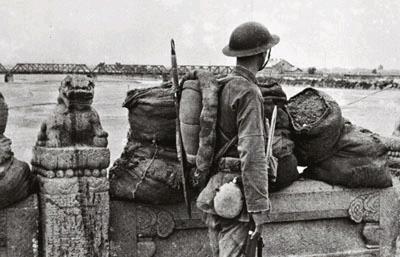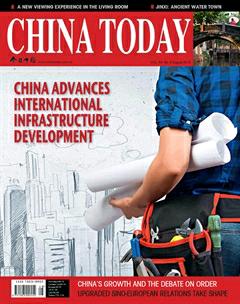The Outbreak of the War
LIUTIAOHU (Willow Lake) Cloverleaf Junction stands at the intersection of the Harbin- Dalian Railway and the First Northeast Ring Road of Shenyang City. The lake that gave the place its name is long gone, replaced by a busy highway and a high-speed rail route. Gao Jian, director of the research department of the 9.18 Historical Museum, showed the reporters a section of track west of Cloverleaf Junction, which, according to her research, is the site of the explosion that Japanese imperialists used as the pretext to invade China in 1931.
At the site now stands an 18-meter-tall monument in the shape of a calendar page showing September 18, 1931. On that night the Independent Garrison Unit of Japans Kwantung Army blew up the section of the South Manchuria Railway at Liutiaohu and blamed the local Chinese army. It used this excuse to bombard the Chinese garrison of Beidaying, so launching the 14-year-long invasion of China.
The True Culprit
At the time of our interview, Gao Jian had just returned from the U.S., where she visited a dozen WWII veterans. Her work and research involved extensive and intensive interviews of witnesses of that time in history in addition to combing through historical documents.
“My museum receives throngs of visitors every day, who leave the exhibition full of emotions, both mournful and wrathful. But as researchers we cannot be consumed by grief. We must fulfill our duty to redeem that piece of history,” Gao said.
As for the motivation for Japans aggression, Gao cited the small-size landmass of the insular country and consequent scarcity of resources, the rule by generals, and the entrenched Bushido values, which gave the country an expansionist stripe. With its fertile soil and rich resources, Northeast China on the other side of the border was naturally deemed a “life line” by radical militarists in Japan.
According to Gao, after the First Sino-Japanese War between 1894 and 1895 and the Russo-Japanese War of 1904, imperialist Japan blackmailed a large amount of reparations from China, and whats more, gained control over the railways in Northeast China and the right to station troops along them. It was the force that “guarded” the 703.7-km South Manchuria Railway which provoked the September 18 Incident.
In the dead of night an explosion erupted at Liutiaohu. Two howitzers in the compound of the Japanese Independent Garrison Unit immediately opened fire at Beidaying barracks, where most Chinese garrison soldiers were asleep. Caught entirely off guard, they were shot or stabbed to death by Japanese soldiers, who, by the next morning, had occupied the Chinese garrison.endprint
Tadashi Hanaya, an official of the Kwantung Army secret service, later wrote in his book entitled This Is How the Manchuria Incident Happened,“Suemori Komoto wired a small explosive device used by cavalrymen on the rail, detonated it and reported to headquarters by phone. On receiving the information, Captain Kawashima and his company waiting north of the railway immediately launched an attack on Beidaying.”
Today, there are few traces of Beidaying at the site except a couple of dilapidated barracks that now serve as warehouses and residences. But the local government is considering building a memorial plaza there. Gao is also planning research themed on the history of Beidaying. “It is where the war and the Chinese peoples resistance against it started. No stone should be left unturned in the research,” she said.
On September 18 every year a bellringing ceremony is held at the square in front of the 9.18 Historical Museum in Shenyang, accompanied by an air raid siren, which resonates across the city. Cars in the downtown areas stop and hoot for three minutes as a reminder to local residents of that piece of history.
The Bombing of Lugou Bridge
Following the September 18 Incident imperialist Japan was poised to occupy the whole of China and sent in troops to this end. By 1936 Japanese forces had besieged Beijing, then called Beiping, from the east, west, and north. And beginning in June that year, those stationed in Fengtai, in the southern suburbs of Beijing, carried out several provocative drills.
Fengtai is famous for Lugou Bridge, the oldest stone arch bridge in the Chinese capital, which was lauded by Marco Polo as the best and one of a kind in the world. It is, therefore, also known as Marco Polo Bridge. “Lugou Bridge sits over the Yongding (Perpetual Stability) River about 15 kilometers southwest of Beiping, on the threshold of the city at its junction with the south. It has been a pivotal transport and cargo distribution center since ancient times,” explained Li Zongyuan, vice curator of the Museum of the Chinese Peoples War of Resistance Against Japanese Aggression. “Once the Japanese invaders took over this bridge, they would be able to seize Beijing, and then the whole of North China with ease.”
On the night of July 7, 1937 the Japanese army demanded entrance to the walled town of Wanping on the pretext of searching for a missing solider. When the local Chinese garrison refused, the Japanese began bombarding Lugou Bridge and, eventually, the town as well.“The July 7 Incident marked the start of Japans full-scale war of aggression against China. The Chinese people rose up to resist it, and China became the worlds first major theater in the antifascism war,” Li said.endprint
Chen Jiansheng, 82, a native of Wanping, has vivid and agonizing memories of the Japanese occupation which still reduce him to tears today. “Under Japanese control Chinese people were slaughtered as casually as swatting a fly,” he recalled.“We were constantly hungry, and never knew when we might be hit by a bomb falling from the sky, as Japanese bombers hovered overhead every day.”
Among the exhibits at the Museum of the Chinese Peoples War of Resistance Against Japanese Aggression, which stands by Lugou Bridge, is a manuscript by a pagoda builder named Luo Dejun, which says: “The Japanese army seized Beijing on June 29 (lunar calendar, corresponding to August 5 on the Gregorian calendar). The war has since spread to the whole nation. Bombardment by artillery and aircraft is everywhere, inflicting untold suffering on the people. There is nothing worse that can be expected. Killing, raping, and looting, all atrocities are being committed...” Zhang Shuanzhong, a guide at the museum, points out this revealing manuscript to every visitor. “In only 148 Chinese words, this brief note is laden with an average mans concern for his nation, and indignation. It reminds us never to forget the past.”
China Contains Japanese Aggressors
“All our countrymen: Beiping and Tianjin are in danger! North China is in danger! The Chinese nation is in danger! A war of resistance by the whole people is our only hope of survival!” The Communist Party of China broadcast this telegraph on July 8, 1937. “This reflects the keen and precise judgment of the situation by the Party,” Li said. The whole nation was mobilized and fought Japans aggression in the following eight years, with success.
“Japan planned to finish its attack in three months before moving north or south into other countries, depending on the situation. But the tenacious resistance by the Chinese people contained its forces, pinning them down in the eastern battlefield. In this sense the Chinese Peoples War of Resistance Against Japanese Aggression made a tremendous contribution to the victory of the worlds anti-fascism war,” Li said.
Statistics show that Japan had a total 34 divisions of land forces in October 1938, 32 of which were deployed in China. By the time the Pacific War broke out in 1941, up to 70 percent of Japanese ground forces were still in China.
Bathed in the glow of the setting sun, Lugou Bridge quietly overlooks the Yongding River. The lions carved on its balustrades, which have fallen victim to the elements over its history of 800 years, have been repaired or replaced. The traffic has been diverted to the new bridge adjacent. Now and then, a bullet train whizzes by along the rail nearby. Otherwise it is a scene of peace and serenity.
“We Chinese have a saying: Danger will befall any country forgetful of the threat of war, and any bellicose country will face the doom of demise. We must contemplate history to learn lessons from it. China was a major force in the war resisting imperialist Japan and defending world peace. It is, and will remain a guardian of peace,” said Li Zongyuan.endprint
- CHINA TODAY的其它文章
- Initiating a New Partnership Between China and Developed Countries
- China and Advanced Economies–A Win-Win Relationship
- Fangshan’s Wineries and Ecological Practices
- Sustainable Development Mode on the“Roof of the World”
- “We Must Grasp the Opportunity that Paris Offers”
- Face History and Maintain Peace

